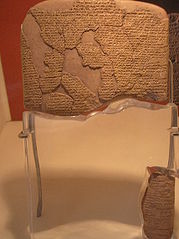- About Pardes
- Podcasts
- Topics
- Downloads
- Donate
 In 1906, the German archeologist, Hugo Winckler, found the remains of the royal archives of the Hittites. He was particularly excited by a copy of the treaty between Egyptian Pharaoh Ramses II and Hittite King Hattusili III. Its content is almost identical to that of the treaty written on a slab in the Temple of Amun at Karnak, and it proved what archeologists already knew – that ancient pacts, like most modern documents, were written in duplicate and a copy kept by each of the parties.[1] (In fact, some scholars believe that this is reflected in the Decalogue or ten commandments written on two tablets—one copy for God and one for Israel. Nowhere does the Bible say, contrary to what is depicted in much synagogue art, that the ten sayings were distributed evenly, five on each tablet.)
In 1906, the German archeologist, Hugo Winckler, found the remains of the royal archives of the Hittites. He was particularly excited by a copy of the treaty between Egyptian Pharaoh Ramses II and Hittite King Hattusili III. Its content is almost identical to that of the treaty written on a slab in the Temple of Amun at Karnak, and it proved what archeologists already knew – that ancient pacts, like most modern documents, were written in duplicate and a copy kept by each of the parties.[1] (In fact, some scholars believe that this is reflected in the Decalogue or ten commandments written on two tablets—one copy for God and one for Israel. Nowhere does the Bible say, contrary to what is depicted in much synagogue art, that the ten sayings were distributed evenly, five on each tablet.)
The biblical scholar George E. Mendenhall applied Winckler’s insights about treaties to the Hebrew Bible, especially Deuteronomy.[2] More recently, the political scientist Daniel J. Elazar noted [3] concerning Deuteronomy 29:28: “The hidden things (nistarot) belong to the Lord, our God, but the revealed things (niglot) apply to us and to our children forever: that we must fulfill all the words of this Torah”:
The conclusion of the covenant emphasizes that the constitution was openly given to the Israelites for them to live by. It is the opposite of those secret things that belong to God. At the conclusion of the covenant ceremony there is a final word reemphasizing that the constitution is close and not distant, that the people are given a choice between good and evil, and that heaven and earth witnessed the covenant, seals the matter.[4]
I would like to build on and extend Elazar’s observations, and claim that by applying what we know of Near Eastern treaties, a form of contracts, we see that Devarim 29:28 is not only a conclusion to the covenant but delicately models what is special about this particular covenant – in what ways this contract is similar and different to a human one and in what ways if differs from some other divine covenants.
 The lector priest in ancient Egypt had secret data and could perform magic;[5] in other religions as well the clergy is believed to have knowledge that is hidden from lay-people. The covenant in Nitzavim is similar to a human covenant in that God’s knowledge is not exclusive, and sufficient information is revealed for us to be able to keep the mitzvot based on what knowledge we do have.
The lector priest in ancient Egypt had secret data and could perform magic;[5] in other religions as well the clergy is believed to have knowledge that is hidden from lay-people. The covenant in Nitzavim is similar to a human covenant in that God’s knowledge is not exclusive, and sufficient information is revealed for us to be able to keep the mitzvot based on what knowledge we do have.
To be sure, we read in the Mishna (Yoma 3:1) that “the house of Garmu would not teach anything about the preparation of the showbread; they of the house of Abtinas would not teach anything about the preparation of the incense; Hygros, son of the tribe of Levi knew a cadence in song but would not teach it; Ben Kamzar would not teach anyone his art of writing;” these are indeed examples of secret knowledge in the hands of special guilds. However, it is significant that this mishna begins by noting “And these were mentioned to their shame,” indicating the rabbi’s disapproval of hoarding knowledge. Our verse emphasizes that hoarding knowledge is God’s prerogative; our job is to share what we know to ensure that the words of the Torah are observed.
In fact, explaining our verse as a polemic against those who would keep religious knowledge secret fits in very well with the larger context in which our verse appears, especially Deuteronomy 30:11-14: “For this commandment which I command you this day, is not concealed from you, nor is it far away. . . It is not in heaven, that you should say, ‘Who will go up to heaven for us and fetch it for us, to tell [it] to us, so that we can fulfill it?’ Nor is it beyond the sea, that you should say, ‘Who will cross to the other side of the sea for us and fetch it for us, to tell [it] to us, so that we can fulfill it?’ Rather, [this] thing is very close to you; it is in your mouth and in your heart, so that you can fulfill it.” Knowledge is a spur to keep the Torah, not an impediment. But can there be too much knowledge? Can familiarity lead to a lessening of the magic and the allure of religion?
Here the difference between this divine covenant and a human one becomes important. In the Egyptian-Hittite peace agreement there were some minimal differences between the Egyptian and Hittite copies, but for Deuteronomy, the difference between the copies is vast. God has entire areas of knowledge (nistarot) that we do not know about.
In a very delicate way, the two parts of this verse get to the heart of what healthy religion is. On one hand, religion needs to be sufficiently open and revealing so that people understand what they are doing and why. To some extent, biblical religion was taking a stand against hidden knowledge in the human realm. Many ancient religious priesthoods derived much of their power by claiming secret knowledge that gave them access to the gods, knowledge that they would not share. Israelite religion, according to this verse, is revealed religion. The rules are known to all and the ability to live life in line with the will of God is available to all—the information is not in heaven and the commandments are “close by.”
On the other hand, a religion without secrets loses its mystique. Hence the verse clarifies, the world is filled with mysteries and secrets known only to God, but these are known only to God and not shared with a select subgroup of Israelites. “The hidden things (nistarot) belong to the Lord, our God, but the revealed things (niglot) apply to us and to our children forever: that we must fulfill all the words of this Torah.”
It is this balance between the revealed (human realm) and the concealed (divine realm) that allows the Torah to function as a covenant accessible to all Israel while allowing the religion to maintain a crucial sense of mystery and awe.
[1] David J. Bederman, International Law in Antiquity (Cambridge: Cambridge University Press, 2001), 147-150. For a recent, comprehensive collection and discussion of ancient treaties, see: Kenneth A. Kitchen and Paul J.N. Lawrence, Treaty, Law and Covenant in the Ancient Near East (Wiesbaden: Harrassowitz Verlag, 2012).
[2] George E. Mendenhall, Law and Covenant in Israel and the Ancient Near East (Pittsburgh: The Biblical Colloquium, 1955).
[3] http://www.jcpa.org/dje/articles2/deut-const.htm.
[4] Daniel J. Elazar Deuteronomy as Israel’s Ancient Constitution: Some Preliminary Reflections (Jerusalem: Jerusalem Center for Public Affairs, 1992),
[5] Denise Doxey, “Priesthood,” in The Oxford Encyclopedia of Ancient Egypt, vol. 3 (ed. Donald B. Redford; Oxford: OxfordUniversity Press, 2001), 69–70.